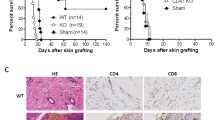Abstract
Active cell death induced by ligation of the Fasantigen (Fas-Ag) with its antibody, Fas ligand (Fas-L),has been known to play a major role in cell killing viaapoptosis by cytotoxic T lymphocytes (CTL). Thus, in liver transplantation, Fas-Agexpression of hepatocytes and its modification byimmunosuppressive agents such as FK 506 or CsA cantheoretically influence allograft survival. Mousehepatocytes (BALB/c) were isolated and cultured with orwithout FK 506 or CsA, and Fas-Ag expression wasdetermined by flow cytometry. Fas-Ag expression in thecontrol was 17.2 ± 2.5% after 24 hr of culture.When FK 506 or CsA was added, Fas-Ag expression withFK 506 at a concentration of 0.01-0.1 μg/ml wassignificantly lower than that with CsA (P < 0.05).When the cells were incubated with apoptosis-inducing anti-Fas-Ag monoclonal antibody, agarose gelelectrophoresis of the control cells yielded a typicalpattern of DNA fragmentations. The cells with FK 506 at0.01 μg/ml yielded the least DNA fragmentation. These findings suggested that in the in vivosetting, the hepatocytes of the allograft would have alower chance of being attacked by CTL in the hosttreated with FK 506.
Similar content being viewed by others
REFERENCES
Kerr JFR, Wyllie AH, Curreis AC: Apoptosis: A basic biological phenomenon with wide ranging implication in tissue kinetics. Br J Cancer 26:239–257, 1972
Nagata S, Yolstein P: The Fas death factor. Science 267:1449–1456, 1995
Alderson MR, Armitage TJ, Maraskovsky E, Tough TW, Touxe, Schooley K, Ramsdell F, and Lynch DH: Fas transduces activation signals in normal human T lymphocytes. J Exp Med 178:2231–2235, 1993
Kagi D, Vignaux F, Ledermann B, Burki K, Depraetere V, Nagata S, Hengartner H, Golsteint P: Fas and perforin pathways as major mechanisms of T cell-mediated cytotoxicity. Science 265:528–530, 1994
Stalder T, Hahn S, Erb P: Fas antigen is the major target molecule for CD4+ T cell-mediated cytotoxicity. J Immunol 152:1127–1133, 1994
Ju ST, Cui H, Panka DJ, Ettinger R, Rothstein AM: Participation of target Fas protein in apoptosis pathway induced by CD4+ Th1 and CD8+ cytotoxic T cells. Proc Natl Acad Sci USA 91:4185–4189, 1994
US Multicenter FK 506 Liver Study Group: A comparison of tacrolimus (FK 506) and cyclosporine for immunosuppression in liver transplantation. N Engl J Med 331:1110–1115, 1994
European FK 506 Multicenter Liver Study Group: Randomised trial comparing tacrolimus (FK 506) and cyclosporin in prevention of liver allograft rejection. Lancet 334:423–428, 1994
Watanabe-Fukunaga R, Brannan CI, Itoh N, Yonehara S, Copeland NG, Jenkins NA, Nagata S: The cDNA structure, expression, and chromosomal assignment of the mouse Fas antigen. J Immunol 148:1274–1279, 1992
Nishimura Y, Ishii A, Kobayashi Y, Yamashita Y, Yonehara S: Expression and function of mouse Fas antigen on immature and mature T cells. J Immunol 154:4395–4403, 1995
Oberhammer F, Bursch W, Tiefenbacher R, Froeschl G, Pavelka M, Purchio T, Schulte-Herman R: Apoptosis induced by transforming growth factor β1 within 5 hours in regressing liver without significant fragmentation of the DNA. Hepatology 18:1238–1246, 1993
Heller RA, Krönke M: Tumor necrosis factor receptor-mediated signaling pathways. J Cell Biol 126:1354–1359, 1994
Owen-Schaub LB, Yonehara S, Crump WL III, Grimm EA: DNA by Fas antigen engagement. Cell Immunol 140:197–205, 1992
Eischen CM, Dick CJ, Leibson PJ: Tyrosine kinase activation provides an early and requisite signal for Fas-induced apoptosis. Immunol 153:1947–1954, 1993
Enari M, Talanian RV, Wong WW, Nagata S: Sequential activation of ICE-like and CPP32-like proteases during Fasmediated apoptosis. Nature 380:720–723, 1996
Laurie B, Schaub O, Radinsky R, Krunzel E, Berry K, Yonehara S: Anti-Fas on nonhematopoietic tumors: Levels of Fas/APO-1 and bcl-2 are not predictive of biological responsiveness. Cancer Res 54:1580–1586, 1994
Hollander GA, Bieerer BE, Burakoff SJ: Molecular mechanism of immunosuppressive drugs: Cyclosporine A, FK 506, and rapamycin. In: NL Tilney, TB Strom, LC Paul (eds). Transplantation Biology. Philadelphia, Lippincott Raven, 1996, pp 657–658
Hartfield SM, Roehm NW: Cyclosporine and FK-506 inhibition of murine mast cell cytokine production. J Pharmacol Exp Ther 262:680–688, 1992
Hiramatsu Y, Hayashi N, Katayama K, Mochizuki K, Kawanishi Y, Kasahara A, Fusamoto H and Kamada T: Immunohistochemical detection of Fas antigen in liver tissue of patients with chronic hepatitis C. Hepatology 19:1354–1359, 1994
Larsen CP, Alexander DZ, Hendrix R, Ritchie SC, Pearson T: Fas mediated cytotoxicity. Transplantation 60:221–224, 1995
Ogasawara J, Watanabe-Fukunaga R, Adachi M, Matsuzawa A, Kasugai T, Kitamura Y, Itoh N, Suda T, and Nagata S: Lethal effect of the anti-Fas antibody in mice. Nature 364:806–809, 1993
Orrenius S, McConkey DJ, Bellomo G, Nicotera P: Role of Ca2+ in toxic cell killing. Tips 10:281–285, 1989
Rights and permissions
About this article
Cite this article
Kobayashi, T., Negita, M., Takagi, H. et al. Fas Antigen Expression of Hepatocytes and Its Modification by Immunosuppressants. Dig Dis Sci 42, 2471–2475 (1997). https://doi.org/10.1023/A:1018848108977
Issue Date:
DOI: https://doi.org/10.1023/A:1018848108977




